Raglan Gatehouse
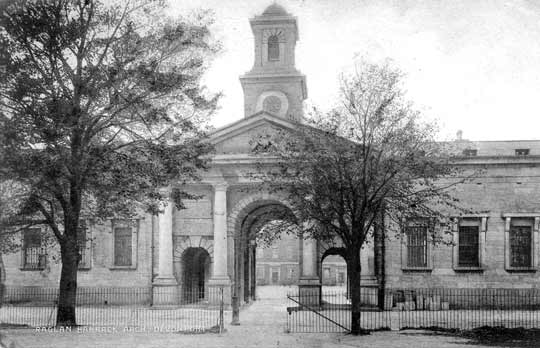
1853-1858
Raglan Gatehouse, also referred to as Raglan Guardhouse or Raglan Main Gateway,
was the main entrance into Raglan barracks. Now the only remaining part of the barracks,
it is located opposite the car park of Plymouth Albion Rugby ground, in what was
once called Military Road, Devonport, but is now called Madden Road. The name Admiral's
Gate has been seen on a city council document, but that is a modern-day error, and
is incorrect.
Raglan Barracks was built between 1853-1858, at the time of the Crimean Wars, and
was named after one of the Allied Commanders of that conflict, Lord Raglan. The grand
gateway into the barracks was designed by Captain Fowke, RE, an emminent architect of the period;
a well known design of his being the Albert Hall in London. The Victorian barracks
replaced a series of smaller 18th century barrack blocks previously located on the same plot; these were
named Frederick, Legonier and Cumberland.
The exterior of the gate structure is described by English Heritage as ... 'single-storey; 9-window range.
Central square clock tower with face to each side and moulded cornice; narrower
bellcote above with moulded corner pilasters and round-arched opening to each side
with rusticated voussoirs; moulded cornice and small dome surmounted by weather
vane. Central vaulted carriageway flanked by lower vaulted pedestrian passages.
Identical inner and outer elevations each with central round archway, and flanking
pedestrian arches with inscribed panels over, fronted by a pedimented tetrastyle
Tuscan portico on pedestals and with Royal Arms to pediment.' The remainder of their
description is found at the
English Heritage website.
On passing through the Gateway, when it was in full use, the immediate view would
have been an enormous parade ground, with army buildings around the perimeter, all
clearly seen in the images on this page. At time of writing, 2011, the entire plot
is now replaced with housing, both private sector and public. The name has stayed
in local memory though, as residents refer to the area, still, as simply 'Raglan'.
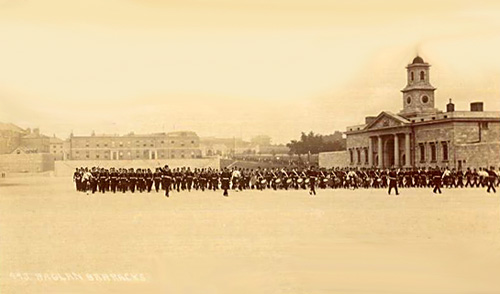
The postcard above shows the huge parade ground once at Raglan, with rear view of
the Gateway. The terrace of buildings high along the back, looking down upon the
parade ground, was present until the late 1960s early 1970s, but is now the site of St Theresa's
apartments for the elderly, in Fore Street.
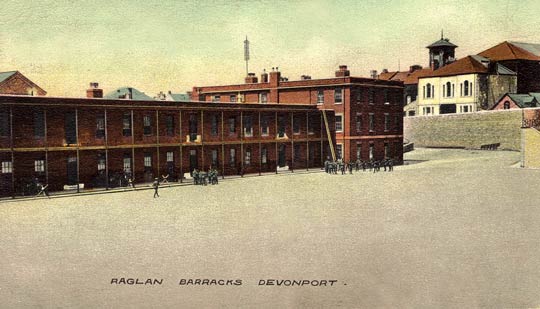
View of army buildings inside the barracks, built in Indian style with flat roofs
and verandahs. The white building behind the wall is now the site of the Welcome
Hall in Fore Street.
The tall perimeter wall to the west of the
barracks, that which runs parallel with Chapel Street, and can be seen in York Street
and Barrack Street, (and continues farther down behind George Street) was/still is, the King's Inner Boundary Wall. It was not built
in Victorian times as part of Raglan Barracks, but was built circa 1787 by the Duke
of Richmond - although it did form a natural western boundary to Raglan Barracks.
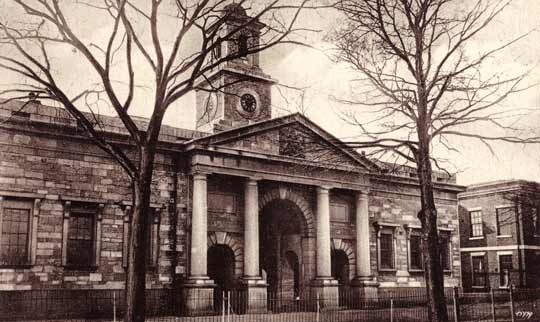
Raglan Gatehouse functioned as both a gateway and a guardhouse. This postcard shows
another view of the full structure, as in use around 1900. The central arch was
for horses, and later motor vehicles, the side arches were for soldiers on foot,
and on either side were identical guard-rooms. The clock on the tower no longer exists.
1887. Prince of Wales Presents Colours
On 4th November 1887 the Prince of Wales visited Devonport in order to present
new colours to the 2nd Battalion Duke of Cornwall's Light Infantry [1]. He'd visited
Devonport several times previously, and on arrival he began a speech
to Devonport Corporation with... "I have had much satisfaction in receiving your
address, and I thank you for your kind welcome to a borough in which on more than
one occasion I have experienced a very cordial reception. ...." Following those
civic cordialities (probably held at the Guildhall in Ker Street?) the Prince was
driven to Raglan Barracks for the Changing of the Colours ceremony, where the regiment
awaited his arrival.
The ceremony went ahead and the old colours were dispensed with as the band played
Auld Lang Syne, then the new colours were duly presented. The Prince then addressed
the troops:--
"Colonel Grieve, Officers, Non-Commissioned Officers, and Men of
the 2nd Battalion Duke of Cornwall's Light Infantry, You have
conferred a great pleasure and satisfaction upon me in having
asked me to give your efficient regiment new colours. I do so
with the greatest pleasure, because ...." (main body of speech omitted here)
The address ended with.... 'There is much more that I could say in
connection with your distinguished services, but, owing to the
want of time and the unfortunate inclemency of the weather, I do
not wish to detain the regiment longer than is necessary on
parade. Let me congratulate you, Colonel Grieve, on the smart
appearance of your regiment and the admirable way in which they
look. I sincerely hope the regiment, as opportunities offer,
though I hope they may not, whether in the defensive or
offensive, will continue as it always has to distinguish itself.
I can congratulate you, Colonel Grieve, upon the honour of
commanding so fine and efficient a regiment."
1895. Duke of Cambridge Presents Colours
On 23rd May 1895, the Duke of Cambridge presented the 2nd Battalion of the Somerset Light Infantry
with new colours [2]. This terrific newspaper image below shows the event taking place at Raglan. Further information about the ceremony is
provided on the website of the
Somerset Light Infantry enthusiasts.
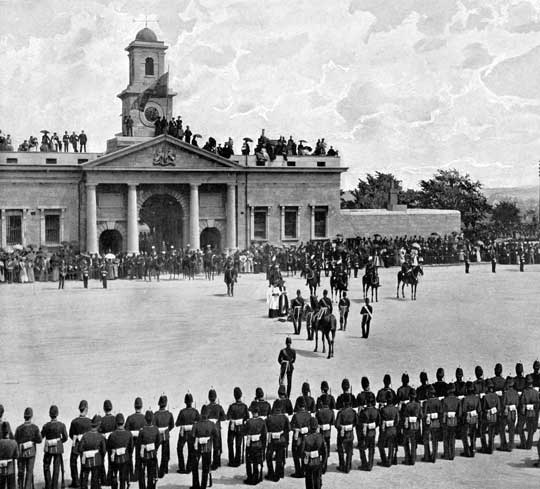
1897. Drainage Problems
The drainage system at Raglan Barracks wasn't very good [3]; over a period of years it was blamed for several
health issues and for being the cause of a diphtheria outbreak in Devonport. Questions
were asked in government about providing money to repair the drains. Hansard, of
15 July 1897 records a Captain Norton asking:
"I beg to ask the Under Secretary of State for War whether, in reference to the
recent outbreak of diphtheria at Devonport, by which two lives were lost, any sanitary
recommendations had been made, and, if so, how far back, by the Army Medical Department
or Royal Engineers respecting defects in the drainage of the Raglan Barracks; and,
if recommendations were made, what were the circumstances that prevented the War
Office from carrying them out?"
MR. BRODRICK replied "In April 1896, the medical officer at Devonport reported that
the drains of the Raglan Barracks were in an unsatisfactory state. Inquiry was made
with the result that the general officer commanding submitted a comprehensive scheme
involving a large cost. This had to be examined before the work could be undertaken.
Money is taken in this year's Estimates, and every effort will be made to press
on the work as quickly as possible."
The drains at Raglan were subsequently repaired and renewed, during which time all soldiers vacated the barracks entirely. Upon completion of
the work the army returned to Raglan.
1936
In 1936 the War Office decreed the barracks to be out of date and demolition was
mooted [4], then World War II broke out so it was left. After the war various government
and minor army departments continued to use some of the buildings for a decade or so. Excepting
the Gatehouse and a few short perimeter walls in Raglan Road, Raglan Barracks was
finally demolished at the end of the 1960s and start of the 1970s.
1975
On 1st May 1975 the Gatehouse became a Listed building:
- List number 1386244.
- National Grid Reference: SX 45619 54673
- Grade II
Around this time Forces married quarters were under construction on the old Raglan site; they were
opened for use the following year. [5]
1991
In 1991 the Ministry of Defence released Raglan Gatehouse for public sale. It was purchased in the same year
by Richard Triscott [6] of Ridge Park Road, Plympton, Plymouth; the sum is believed to have been £18,000.
1993
The mid-1970s married quarters at Raglan did not appear to have been used much by Forces families as, by
1993, the government were discussing their sale; Hansard [7] recorded this conversation ...
Mr. Jamieson : To ask the Secretary of State for Defence if he will make a statement
on the progress of the discussions with Devon and Cornwall housing association to
acquire empty Ministry of Defence dwellings at Raglan barracks, Mount Wise, Plymouth.
Mr. Archie Hamilton : The sale of the former married quarters estate at Raglan barracks
has been agreed in principle but the Devon and Cornwall housing association--DCHA--has
been unable to secure the necessary funding for completing the purchase. In order
to ensure that the empty properties are brought back into early use and with DCHA
agreement, the properties have now been placed on the open market.
2002
In 2002 a newspaper article [8] mentioned that a planning application
had been submitted by the owners of the Grade II listed Raglan Gatehouse
to demolish the building and replace it with houses. The article continued..' Geoffrey
Smith, the owner's agent, said permission had been secured to use the building
as offices but nobody had come forward. "Nobody wants to see it demolished but if
nobody wants to, or can, use it, it will only decay unless a sensible development
goes ahead," he said.'
Unfortunately the words in that article came true, development did not go
ahead and the building decayed. But it has to be said the decay
is due solely to the owner not maintaining the building whatsoever.
2004
Sadly, the Gatehouse appears to have been purchased by Richard Triscott as an investment
only. Having purchased it for £18k in 1991, then having obtained planning
permission for offices in 2002, he finally sold it [6] for £120.000, in May 2004, to
Drayton Properties Limited, 53 Drayton Green road, London W13 0NQ.
Drayton Properties also seem to have bought the building as an investment. Only four
months after their purchase Drayton Properties placed
the Gatehouse for auction at more than 50% increase in value. The bidding, which took place in September 2004 at Novotel, Plymouth, reached
£180,000 but was unsold as it failed to achieve the reserve price [9].
2005
The Gatehouse was placed on the city's Buildings at Risk Register (BAR) for the
third time.
2009
This great building has consistently suffered from vandalism, and several attempts
have been made to clean it. The image below is from one such attempt on 19th February,
2009 [10]
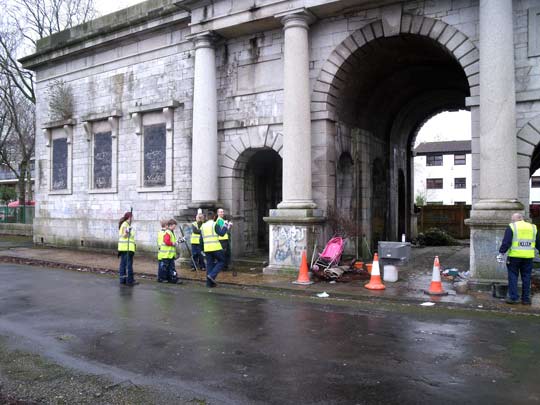
Pembroke Street Youth spent part of their half-term holidays cleaning up the Gatehouse.
Read more about the story and see the images of
Pembroke Street Youth Volunteers.
2011
Raglan Gatehouse is struggling to survive, since being released by MoD and sold
on the open market, successive owners have failed to maintain it. It has fallen
into massive disrepair, trees are even growing out through the roof - rather, what
was once the roof, it collapsed a while back. The city council have placed it on
the Buildings At Risk Register three times and, I'm led to understand, are encouraging
the owners to address the issue. At time of writing the Gatehouse is still for sale.
To the everyday onlooker like myself, it appears the owners actively want the building
to continue decaying, they want it to fall into total disrepair, beyond rebuild, so that a new
building(s) can rise in its place.
Although it's possible to walk through the arches and look around the structure,
access into the old guard rooms on either side is barred by gates. These next images
reveal the delapidated condition.
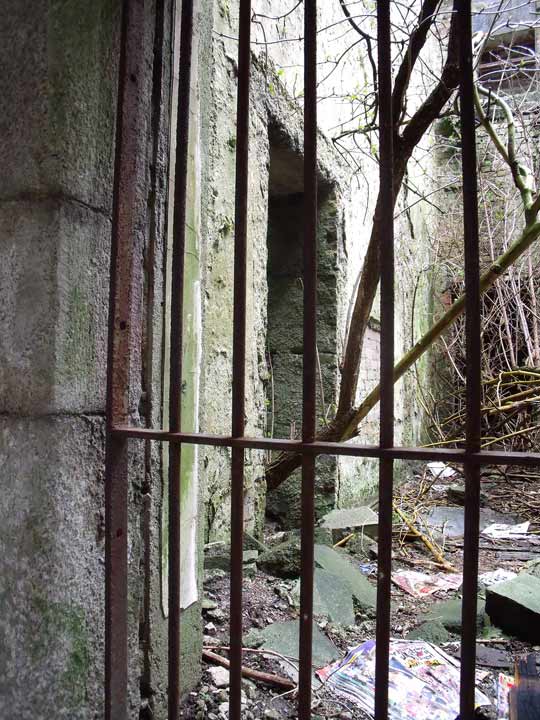
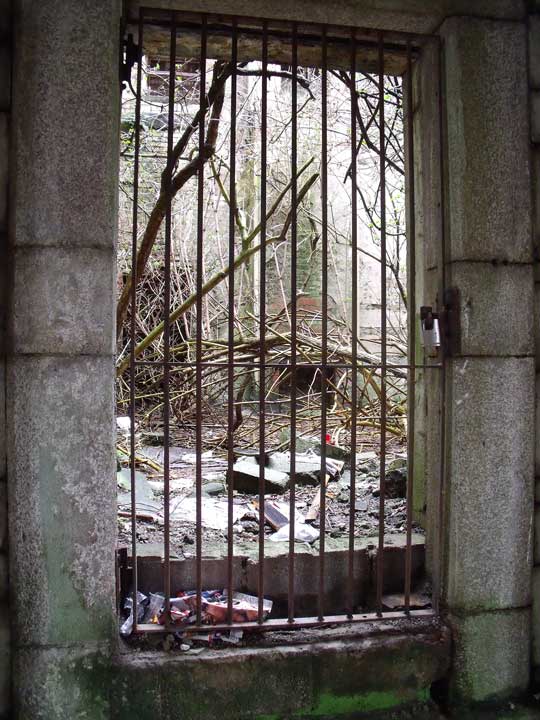
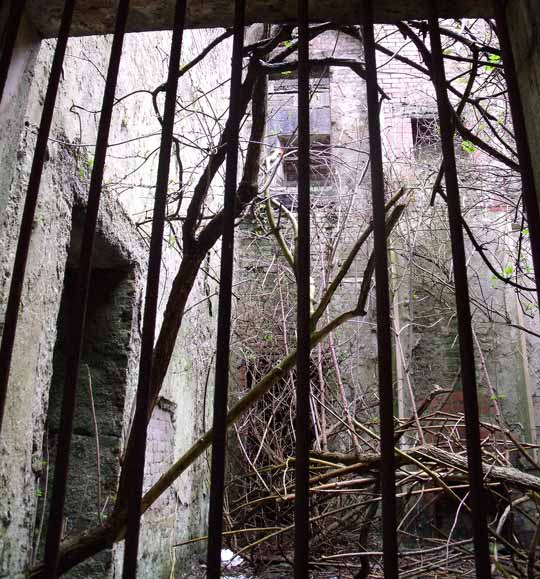
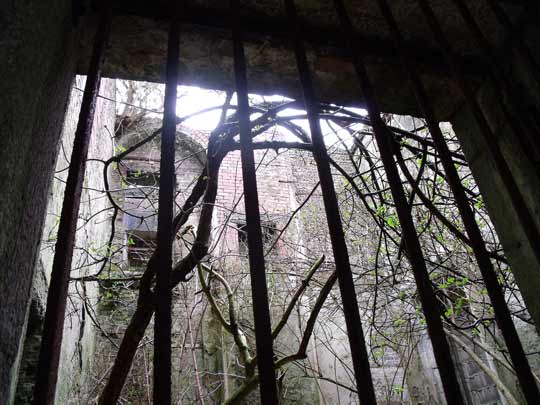
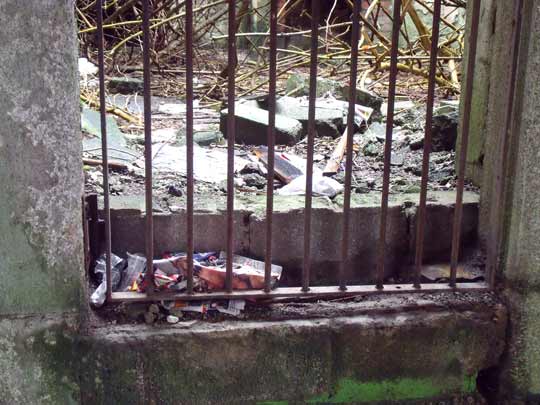
One big shame isn't it?
.............................................................................................................................................
Sources:
[1] The Project Gutenberg EBook of Speeches and Addresses of H. R. H. the Prince
of Wales: 1863-1888. (EBook number 32848) Available from
www.gutenberg.org
[2] Website of the enthusiasts for the
Somerset Light Infantry.
[3] Hansard. 15th July 1897. Discussion of sanitation at Raglan Barracks.
[4[ Brian Mosely. PlymouthData website
Raglan Barracks
[5 ] Chris Robinson. 1985.
Plymouth As Time Draws On. Pen & Ink Publishing
[6] Confirmed with the Land Registry database on 23 Sept 2004.
[7] House of Commons Hansard Debates for 22nd April 1993 - Departmental Properties
[8] The Evening Herald newspaper. March 2002 (apologies, I have the newspaper cutting
but am not aware of which day in March it was published)
[9] I was present at the auction - Liz.
[10] I attended the event and took many photographs - Liz.
Liz Cook 19 July 2011